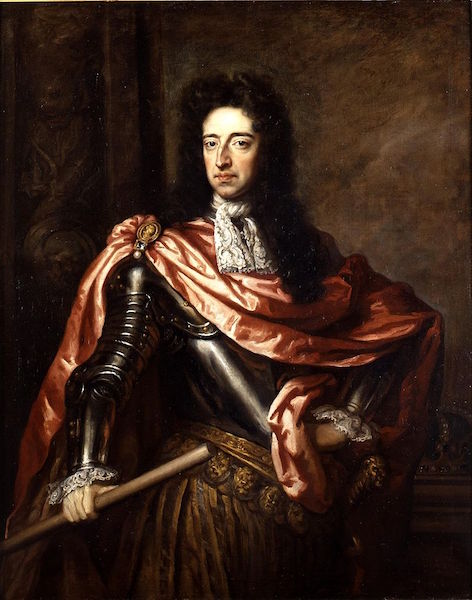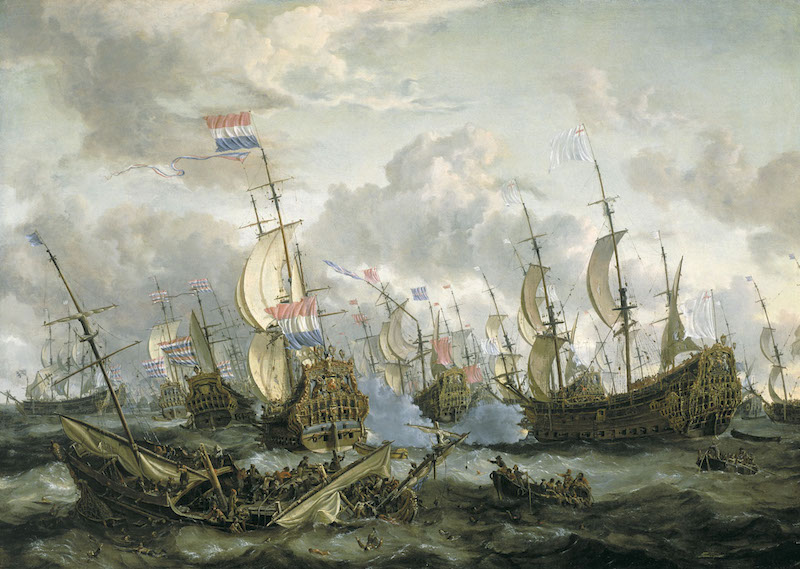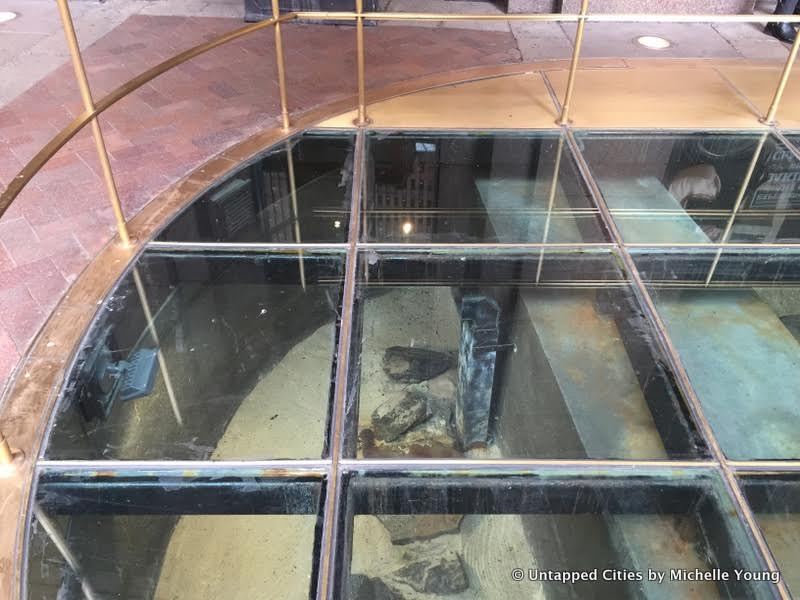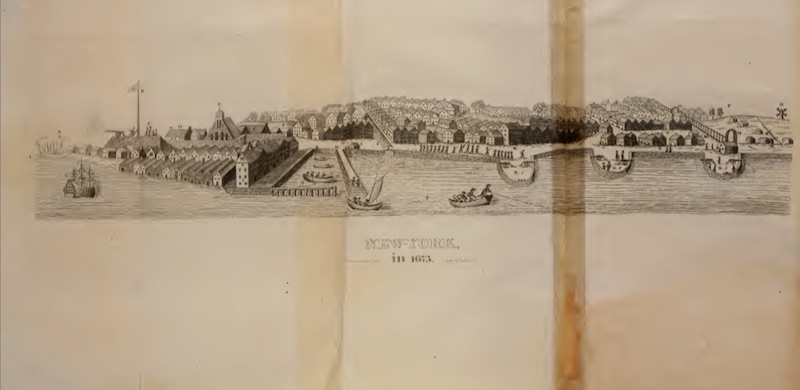
Little known New York City fact: New York became Dutch again for about seven months. The city formally known as New Amsterdam turned New York was rechristened once again as New Orange on August 22, 1673. We know we’re a little obsessed with Dutch history, but this is too fun not to mention because it’s such a crazy little blip on the New York City historical radar.
Two prior Anglo-Dutch Wars apparently weren’t enough for King Charles II and he was hoping the third time would be a charm. In 1670 he signed a treaty with French King Louis XIV committing both nations to unite against the Dutch should they misbehave. And misbehave they did. After the Dutch attacked the English on their own eponymous channel in 1672, both the English and French immediately declared war on the Netherlands.
 Prince William of Orange later King William III of England. Source: Wikipedia Commons.
Prince William of Orange later King William III of England. Source: Wikipedia Commons.
A fiery Prince William of Orange rallied his small country against France and England despite the stacked odds against him. He leveraged his impressive navy to take back the territories England acquired less than ten years prior. He placed Admiral Cornelis Evertsen in command whose reputation for high-seas cunning earned him the nickname “Kees the Devil.” And Everton lived up to the hype. First he sailed the fleet into the Caribbean pillaging a fortune in spices and slaves then proceeded to sail up to the Chesapeake making kindling of quite a few English ships, stealing thousands of pounds of tobacco then quickly hightailing it north. Next stop: New York.
 The Dutch fleet in battle with the English during the Second Anglo-Dutch War. Image source: Wikipedia Commons.
The Dutch fleet in battle with the English during the Second Anglo-Dutch War. Image source: Wikipedia Commons.
In July of 1673 Evertsen parked the Dutch fleet off of Sandy Hook. According to Gotham, some Dutch farmers from New Utrecht sailed out to Evertsen claiming that life under English rule was hard and they would happily back a Dutch takeover. They also said that Governor Lovelace (more on him in a moment), who was off in New Haven creating a dumb postal route to Boston and Fort James (formally Fort Amsterdam), was a total mess. Irons were hot and it was time to strike. But first…
…Governor Francis Lovelace: Besides being able to see the foundation of his home/tavern on our Remnants of Dutch New Amsterdam Tour, he was the second Royal Governor of New York replacing Richard Nicolls who replaced Peg Leg Peter Stuyvesant in 1664. Lovelace was one of those guys who came in with a lot of ideas on how to make New York more English and less Dutch. One of them was to get rid of the burgher class system which gave more power and rights to richer burgers over more modestly middle class burghers.
 The preserved remains of Governor Lovelace’s Tavern at 85 Broad Street in Lower Manhattan.
The preserved remains of Governor Lovelace’s Tavern at 85 Broad Street in Lower Manhattan.
Join us on an upcoming tour of the Remnants of Dutch New Amsterdam where you can see the Lovelace Tavern foundations and much more!
Tour of The Remnants of Dutch New Amsterdam
The robust Dutch remnant community from New Amsterdam did not dig Lovelace’s new changes since he was also heavy-handed with taxes to fund infrastructure initiatives. This included the Boston Post Road which was his pet project with New England Governor John Winthrop Jr. The route started on Broadway and weaved its way up to Boston through Westchester and Connecticut with a hired rider delivering mail between the two cities on a monthly basis.
Now back to the insurrection already in progress… On August 20th, a battalion of Dutchmen lead by Captain Anthony Colve set up guns along the shore of the East River by City Hall (now Pearl Street and Coentes Slip… also on the tour). Evertsen, almost on cue, sailed his ships within firing range of Fort James. Colve ordered temporary English Commander John Manning to surrender or the Dutch forces would level the city. Actually what they really said was, “We have come to bring the country back under obedience to their High Mightinesses the Lord States General.” Manning did nothing and Colve loaded 600 more men onto the Hudson shore roughly around Trinity Church. According to Gotham, “Cheered on by ‘demonstrations of joy’ among the Dutch populace, Colve and his marines advanced down Broadway and took possession of the fort without firing a shot.”
Wash, rinse and repeat the same exact scenario as nine years prior with Stuyvesant and the English. By August 22nd, before it was the Big Apple New York became the New Orange renamed in honor of the Netherland’s fearless leader Prince William of Orange (who will, believe or not, become King William III of England in 1689).
Captain Colve was made Governor General of New Orange by Evertsen who promptly left to continue his Supermarket Sweep of English holdings in Newfoundland. Colve immediately restored the Dutch system of government and started levying taxes to strengthen the cities defenses against English retaliation. With postal routes on the brain, Governor Lovelace actually returned to New York/New Orange only to get thrown in jail by Colve who eventually shipped him back to England. There Charles II threw him in the Tower for his incompetence.
 A sketch of New York/New Orange in 1673 scanned from one of the only books on the subject called View of the City of New Orange as It Was in the Year 1673 written in 1825 by Joseph White Moulton.
A sketch of New York/New Orange in 1673 scanned from one of the only books on the subject called View of the City of New Orange as It Was in the Year 1673 written in 1825 by Joseph White Moulton.
But alas all sides grew tired of Anglo-Dutch War #3. Both the Dutch and English were nearly bankrupt so their hearts weren’t really in it. They made nice, exchanged some territories and went home. England got New York back, the Dutch got Suriname and in February of 1674 a peace treaty was signed.
Apparently the New Orange Dutch hold-outs were livid about the turn over. Some went to Suriname while Colve and his crew boarded a ship back to Amsterdam. Hardcore Dutch New Yorkers like Jeremias Van Rensselaer decided to stick it out. He wrote, “Well if it has to be, we commend the matter to God, who knows what is best for us.” With true Dutch comic timing he finished his thought, “We didn’t count on such a blow, God knows.”
You can hear stories like this and others examining life in New York during this time period on our Remnants of Dutch New Amsterdam: Tracing the Castello Plan Tour:
Tour of The Remnants of Dutch New Amsterdam
Next, read about 10 things the Dutch introduced to NYC.





